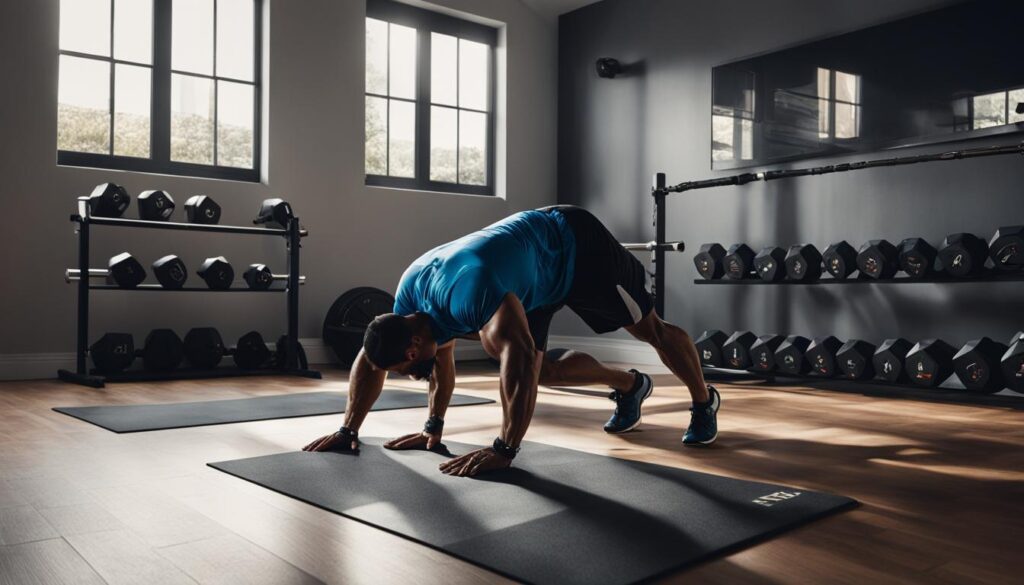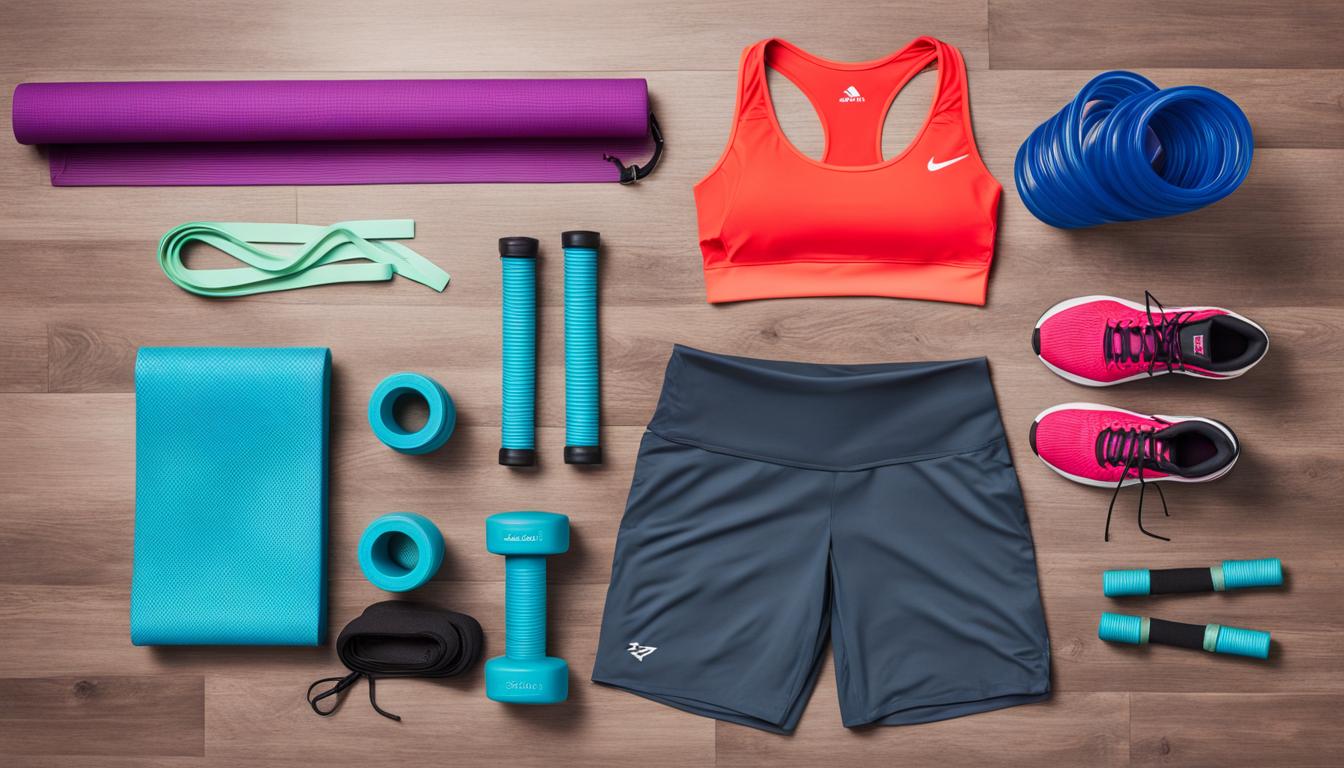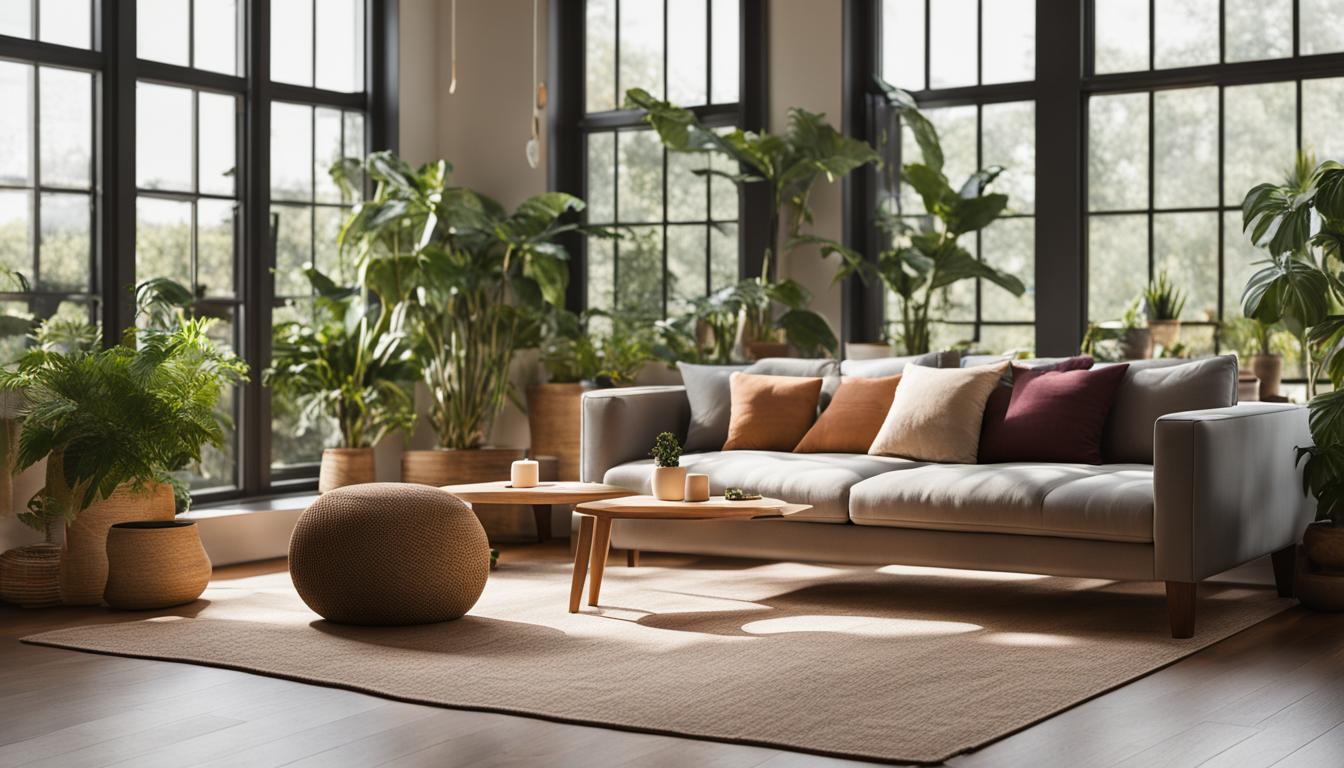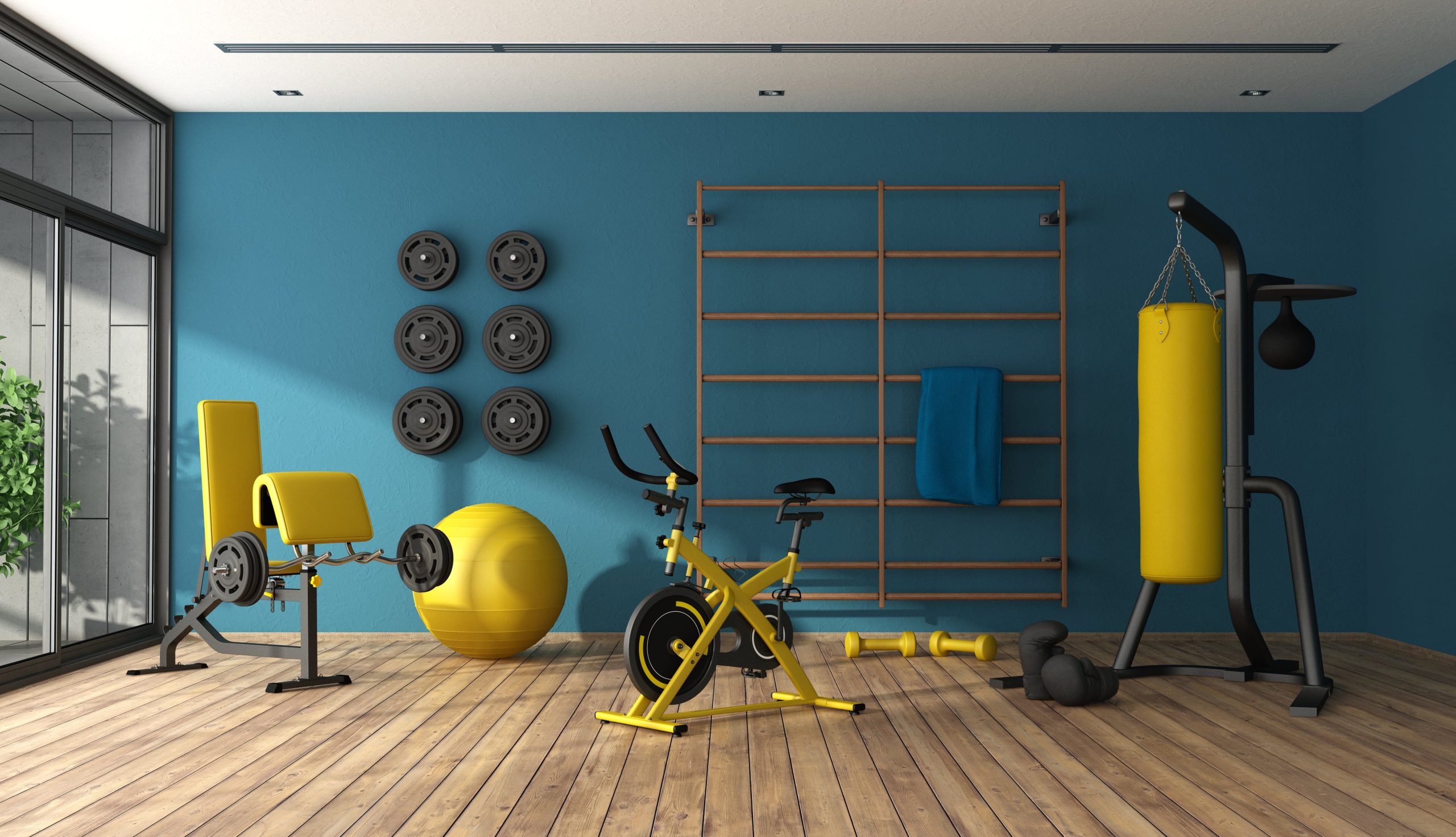Discover the freedom and flexibility that comes with transforming your home into a personal fitness haven. With effective home workouts, you’re no longer tied to gym hours or equipment availability—your fitness journey moulds seamlessly to your life’s rhythm. Whether you’re crafting workout routines for home amid a busy schedule or seeking privacy in your exercise regime, this guide empowers you with practical home workout tips to establish a rewarding and adaptable fitness routine. Perfect your workouts at your pace, on your terms, and watch as your personal well-being flourishes in the comfort of your own space.
Key Takeaways
- Embrace the convenience of customizing your workout schedule without gym constraints.
- Enhance your exercise routine with versatile and space-saving equipment selections.
- Maximize your workouts with creative and effective strategies to fit your unique lifestyle.
- Gain insights into forming habits that make regular home exercise enjoyable and sustainable.
- Unlock the potential for impressive fitness gains by utilizing your personal space effectively.
The Increasing Popularity of Home Fitness Regimens
As the hustle of daily life intensifies, more individuals are turning to the convenience and flexibility of at-home fitness routines. The elimination of travel time to a gym coupled with the high costs of memberships are compelling reasons why many are transitioning into home workout plans. This trend is not merely about accessibility; it’s about customizing an exercise experience that aligns with personal preferences and time constraints.
Why More People Are Skipping the Gym for Home Workouts
The reasons for this shift are manifold. Chief among them is the unmatched convenience that at-home fitness routines offer. Instead of scheduling your day around the gym, you can now design an effective bodyweight exercise routine that fits snugly into your timetable. The reduction of commute time alone acts as a catalyst, pushing you toward more consistent and efficient workouts.
Moreover, the privacy of exercising in your personal space allows you to work out without self-consciousness or peer pressure. This sense of comfort and autonomy is empowering, making at-home fitness routines not just an alternative to the gym, but a preferred method of keeping fit for many.
The Surprising Benefits of Exercising at Home
The benefits of a home-based workout regimen extend beyond mere convenience. It reinforces the habit of self-discipline, as you are solely responsible for your exercise routines. When you incorporate home workout plans into your daily routine, you invest in an activity that pays mental and physical dividends. You can execute workouts on your terms, which makes it easier to stick with your fitness goals.
Let’s look at some popular equipment choices for at-home fitness enthusiasts:
| Equipment | Type of Exercise | Benefits |
|---|---|---|
| Resistance Bands | Strength Training | Portable, versatile, and suitable for a range of fitness levels. |
| Dumbbells | Weight Training | Excellent for building muscle, enhancing coordination and adding intensity to workouts. |
| Yoga Mat | Flexibility & Core Exercises | Provides a comfortable and stable platform for exercises, including yoga and pilates. |
With these simple tools, even a living room corner can be transformed into an effective workout space, making regular exercise more feasible than ever. So, whether you’re pressing for time or seeking a more personalized workout experience, at-home fitness routines are proving to be a sustainable and valuable choice for people looking to improve their health and well-being.
Creating Your Ideal Workout Environment
Embarking upon the journey of home workout challenges requires not just commitment to exercise, but also the cultivation of a space that encourages and motivates you. A well-thought-out workout environment is a stepping stone to a successful home workout program. It’s more than just a room; it’s your fitness sanctuary. Here are a few strategies to turn your home into an optimal workout space that will keep you inspired every day.
- Choose a designated area in your home that is specifically for workouts to establish a clear boundary and signal to your mind that it’s time for exercise.
- Ensure your space is clean and free of clutter, removing any distractions that could hinder your focus during home exercise routines.
- Invest in quality equipment that suits your fitness goals, whether that’s yoga mats for flexibility work or resistance bands for strength training.
- Consider the lighting in your exercise area; natural light can boost your mood and energy levels.
- Add a personal touch with inspirational posters, or set up a screen to follow along with online workout programs.
- Keep the air fresh and consider temperature control — too hot or too cold can affect your performance.
Remember, your workout environment should align with your personal preferences. Some may favour a minimalist approach, finding peace in simplicity which helps focus on the routine. Others might thrive in a vibrant space, energized by bright colours and dynamic decor. Regardless, the key is to create a space that makes you want to return again and again, a place you associate with health, vitality, and progress.
Commit to enhancing this space over time, and allow it to evolve as you do. By doing so, you fortify the foundation of a consistent home workout program that’s capable of overcoming any indoor fitness challenge. Let your workout environment be your ally on the path to peak physical and mental well-being.
The Essential Home Workout Equipment Guide
Forging a fitness regimen at home can be both rewarding and practical. You don’t need a sprawling gym setup to achieve remarkable results—just a few pieces of compact, multipurpose equipment. Below, you’ll discover the essential items that can empower you to build strength, improve cardiovascular health, and enhance flexibility, all within the comfort of your home.
Resistance Training with Bands and Weights
If you’re searching for home workout tips and the best exercises for home, starting with resistance training is a sound strategy. Resistance bands are a versatile, space-saving, and cost-efficient option to target different muscle groups. Whether you’re stretching, doing pull-apart, or integrating them into traditional lifting exercises, these bands are indispensable for a progressive resistance workout.
Weights are the cornerstone of any strength-building routine, and incorporating dumbbells or kettlebells can provide you with the opportunity to perform a full spectrum of exercises like presses, rows, squats, and more. Consider adjustable dumbbells for a customizable, space-conscious option that grows with your strength gains.
Cardio Solutions: Jump Ropes and Portable Options
A good cardio session doesn’t require a high-end treadmill or elliptical. Instead, a quality jump rope can offer an exhilarating workout that enhances coordination, stamina, and cardiovascular endurance. With jump roping, a short and intense workout can have a significant impact on your aerobic health.
For those seeking diversity in their cardio exercises, portable equipment like a pull-up bar can be installed in a doorway, allowing you to engage in various pull-up modifications and core exercises. These tools, especially when complemented with a yoga or gym mat for a comfortable foundation during floor exercises, can radically transform your home workout routine. With this comprehensive home workout equipment guide, you’re all set to challenge your body and meet your fitness objectives without stepping out of your door.
Establishing a Routine for At-Home Fitness Success
Achieving your fitness goals from the comfort of your home has never been more attainable. With the right home workout plans and a commitment to consistency, you can forge a path to success. But it isn’t just about knowing what exercises to do; it’s about crafting a structured routine that aligns with your life.
Designing a Balanced Home Exercise Program
Creating a balanced home exercise program demands a mixture of various types of workouts. It’s essential to blend cardiovascular activities, strength training, and flexibility exercises to ensure a holistic approach to your overall health and fitness. Tailoring your workouts to match your individual preferences and fitness level is key in maintaining high motivation and adherence to your regimen.
Maintaining Motivation and Consistency
Motivation wanes and so understanding how to maintain it is fundamental to your home exercise routines. One proven method is the establishment of clear, achievable goals. Breaking down your long-term fitness aims into smaller, measurable targets helps create a sense of accomplishment and keeps you on track. To boost consistency, schedule your workouts as you would any important appointment – consistency is the bedrock of fitness success.
| Day | Cardiovascular | Strength | Flexibility |
|---|---|---|---|
| Monday | 20 min brisk walk | Full body workout with resistance bands | 10 min stretching |
| Wednesday | 15 min jump rope | Upper body dumbbell circuit | 10 min yoga |
| Friday | 30 min cycling | Lower body bodyweight exercises | 10 min foam rolling |
| Sunday | 30 min dance workout | Core strengthening | 10 min stretching |
Remember, your effective home workouts do not have to be overly complex or time-consuming. With the right plan and a steadfast mindset, you can reap the rewards of a convenient yet powerful at-home fitness routine. So, lace up your sneakers and embrace the journey to a healthier you.
Customizing Workouts to Fit Your Space and Schedule
When it comes to creating effective bodyweight exercises and workout routines for home, one size does not fit all. Your living space and daily schedule are uniquely yours, so why shouldn’t your workouts be the same? It’s essential to carve out a fitness regime that not only challenges you but also slides into your lifestyle like the perfect pair of sneakers.
Start by evaluating the space you have. Whether it’s a small corner in your bedroom or a dedicated area in the living room, it’s possible to design home workout challenges that maximize your available square footage. All you need is your body and perhaps a few pieces of portable equipment. Use the versatility of bodyweight exercises like push-ups, planks, and lunges to create a circuit that packs a punch without crowding your space.
“The key is not the will to win… everybody has that. It is the will to prepare to win that is important.” – Bobby Knight
Remember, flexibility is your friend; fitting a workout into a hectic day might seem daunting, but with a little creativity, it’s entirely feasible. Here’s how to keep your body moving and your fitness goals on track:
- Schedule your workouts as you would any other important appointment.
- Adapt exercises to use common household items as impromptu gym equipment, like using a chair for tricep dips.
- Practice high-intensity interval training (HIIT) for a quick and effective workout when time is of the essence.
- Embrace shorter, more frequent sessions if a long workout isn’t possible.
Your home workout should not only fit into your life seamlessly, but it should also be a delight that you look forward to. Design your exercises around your favourite part of the day, whether it’s right after you wake up – when the world is still quiet – or at the end of the day when you need to decompress. The beauty of home workout routines is that they bend to your will, not the other way around.
With commitment and a bit of ingenuity, you can construct an at-home workout that’s tailor-made for your lifestyle, ensuring you stay active, healthy, and energized to tackle whatever challenges come your way.
Effective Home Workouts: Maximizing Your Results
Home workout programs have evolved, becoming a steadfast way to achieve remarkable fitness results from the comfort of your own space. To enhance the effectiveness of your regimen, certain strategies are paramount, ensuring your efforts are not only consistent but also increasingly challenging to promote continual growth and progress.
Incorporating High-Intensity Interval Training (HIIT)
One of the most dynamic methods to maximize your home workout results is through High-Intensity Interval Training, commonly known as HIIT. This approach toggles between short bursts of high-intensity exercises and brief recovery periods, rapidly enhancing your cardiovascular capacity while accelerating fat burn. Notifications can swiftly become a thing of the past as you relish in the afterburn effect, where your body continues to torch calories even after your workout is complete.

Utilizing Bodyweight for Strength and Endurance
Another cornerstone of an effective home workout is the use of bodyweight exercises. Whether it’s push-ups, squats, or planks, these movements harness your weight to build strength and endurance. As your fitness journey advances, the complexity and intensity of these exercises can be scaled to match your growing capabilities, ensuring a perpetual challenge.
| Exercise | Benefits | Progression |
|---|---|---|
| Push-Ups | Upper body strength, core stability | Decline push-ups, plyometric push-ups |
| Squats | Lower body power, core engagement | Jump squats, pistol squats |
| Planks | Core endurance, posture improvement | Side planks, plank with leg lifts |
By blending HIIT with strategic bodyweight exercises, you lay the groundwork for a home workout program that not only meets but exceeds your fitness aspirations. Keep pushing your limits, diversifying your routines, and maximizing home workout results will inevitably follow.
Overcoming Common Home Workout Challenges
Whether you’re a seasoned athlete or just starting your fitness journey, home workouts can be a game-changer for your routine. However, they often come with their own set of challenges such as limited space and unavoidable distractions. With the right home workout tips, you can transform any small space into an effective gym, and tailor the best exercises for home to fit your unique situation, ensuring your workouts remain effective and engaging.
Dealing with Limited Space and Distractions
You might not have a sprawling gym, but that doesn’t mean your workouts should suffer. The key is to be creative with your exercises and utilize every inch of available space. For instance, using just a yoga mat’s worth of floor space can open up a wide range of workout possibilities. To minimize distractions, try to establish a designated workout area free from interruptions, and consider scheduling your workouts during quieter times or when you’re less likely to be disturbed.
Adapting Exercises for Any Fitness Level
It’s essential to recognize that not every exercise fits all fitness levels, especially when working out at home without a personal trainer’s guidance. Don’t hesitate to adjust the intensity and complexity of workouts to match your capabilities. If high-impact movements are too much, explore low-impact alternatives that still get your heart rate up and strengthen your muscles. Remember, consistency is far more significant than intensity when it comes to long-term fitness success.
| Exercise | Space Required | High-Impact Version | Low-Impact Alternative |
|---|---|---|---|
| Jumping Jacks | 1 sq. meter | Traditional Jumping Jacks | Step Out Jacks |
| Burpees | 2 sq. meters | Full Burpees with Push-up | Standing Burpee with Knee Raise |
| Sprints | 3 sq. meters (linear) | High-Knee Sprints | Marching in Place |
| Mountain Climbers | 1 sq. meter | Traditional Mountain Climbers | Slower Paced, Elevated Surface |
Preventing Injury and Ensuring Safe Exercise Practices
Whether you’re a seasoned athlete or someone just embarking on home exercise routines, the importance of safe exercise practices can’t be overstated. In the absence of a personal trainer, you must embrace self-guidance to avoid common home workout challenges and prevent injury.
To begin with, ensure that you understand the mechanics behind each exercise. You can do this by watching instructional videos from certified fitness professionals. These resources are invaluable for learning the nuances of proper form and they can often offer modifications to accommodate different fitness levels and physical limitations.
Consider the following home workout essentials to keep your sessions both effective and safe:
- Begin every workout with a warm-up to prepare your muscles and joints.
- Invest in a quality gym mat to provide the proper support for floor exercises.
- Keep water nearby to stay hydrated and take breaks as needed.
- Pay attention to your body’s signals—pain is a warning, not a challenge.
- End with a cool-down session to reduce muscle stiffness and aid recovery.
Armed with knowledge and the right mindset, you can tackle your home exercise routines with confidence. Remember that when adopting new exercises, patience is key; take the time to learn and integrate proper form gradually. Your dedication to safe exercise practices will ensure a long-term, injury-free fitness journey from the comfort of your home.
Tracking Progress: Setting Benchmarks and Goals
Adopting at-home fitness routines doesn’t end at execution; it’s about tracking growth to maximize your efforts. As you invest time into your home workout programs, measuring fitness progress becomes critical in fueling your motivation and guiding your journey towards elevated health and strength. Personal benchmarks and specific goals anchor your commitment, transforming every drop of sweat into a stepping stone towards tangible results.
Measuring Improvements in Strength and Cardiovascular Health
Strength and cardiovascular health are two pillars of physical fitness that can be enhanced through dedicated home workouts. The beauty of measuring fitness progress lies in the clarity it provides. By keeping an eye on improvements, such as how many push-ups you can perform, or how quickly your heart rate recovers after intensive exercise, you craft a narrative of advancement that’s both inspiring and indicative of your physical capacity.

Transitioning from the initial stage of setting up a fitness routine to cultivating an upward trajectory in your strength and endurance underscores the need for an effective tracking system. Let’s direct our attention towards the markers that matter most in gauging progress.
| Parameter | Initial Benchmark | Current Level | Target Goal |
|---|---|---|---|
| Push-Ups (in 1 min) | 15 | 25 | 35 |
| 1-Mile Run Time | 10 min | 8 min | 7 min |
| Plank Duration | 30 sec | 1 min | 2 min |
When to Adjust Your Home Workout Plan
Knowing when to adjust your home workout plan can be as significant as the workouts themselves. As your body adapts and your proficiency increases, the same routines that once posed a challenge may no longer yield the same results. If your benchmarks indicate that the gap between your current level and target goal is narrowing, consider this a green light to up the ante. Introducing variations, escalating intensity, or integrating novel exercises can jump-start your progression and maintain the trajectory of your improvement.
Remember, muscle memory is real, and your body thrives on challenge, so don’t shy away from reshaping your home workout programs when your accomplishments signal it’s time for change. Regular assessments act as your compass, steering your fitness voyage towards uncharted territories of personal bests and health milestones.
Nourishing Your Body for Optimal Performance
When you commit to a regimen of effective bodyweight exercises and seek home workout tips, one key element to ensure optimal performance is the way you fuel body for workouts. It’s not just the exercises that count but also how you nourish your body. A well-balanced diet is the cornerstone of robust health and fitness, enabling you to power through every squat, push-up, and lunge with vigor.
The right mix of nutrients can make all the difference in your workout routine. Carbohydrates are your body’s primary fuel source, especially during high-intensity workouts. Pair them with protein to help repair and build muscle tissue post-workout. Don’t forget the healthy fats, which are essential for long-term energy and supporting cellular functions.
| Nutrient | Benefits | Food Sources |
|---|---|---|
| Carbohydrates | Instant energy source | Whole grains, fruits, vegetables |
| Proteins | Muscle repair and growth | Lean meats, legumes, dairy |
| Healthy Fats | Sustained energy, nutrient absorption | Nuts, seeds, avocados, olive oil |
| Water | Hydration, temperature control | Water, infusions, non-caffeinated beverages |
Hydration is another piece of the puzzle that isn’t to be overlooked. Ensuring you drink plenty of water before, during, and after your workouts helps to regulate your body temperature, keep joints lubricated, and aid in transporting nutrients to give you energy and keep you healthy. If you’re well-hydrated, you’ll be better equipped to push your limits during those effective bodyweight exercises.
Embracing these dietary guidelines not only enhances the impact of your home workout tips, but it catalyzes recovery, helping you bounce back faster and be ready to tackle your next session. Just remember, the key to success is consistency, both in your workouts and in nourishing your body correctly. Strap on your workout gear, remember these nutrition tips, and you’re set to make each home workout count!
The Underrated Importance of Recovery in Home Workouts
As you diligently follow your home workout plans and execute your home exercise routines, it’s easy to overlook a critical element that contributes significantly to your fitness success: recovery. Often sidelined, recovery is actually a powerful tool that ensures your hard work pays off, giving your body the necessary time to repair, rebuild, and strengthen.
It’s not just about taking days off; it’s about smartly incorporating into your regimen practices that promote healing and readiness for the next workout. Let’s delve into some effective active recovery techniques that will keep you on track with your fitness goals, without risking overtraining or injury.
Rest Days: Balancing Exercise and Recovery
Rest days should be an integral part of your workout plan. They allow muscles to repair, provide a mental break, and help prevent burnout. This doesn’t mean you need to be completely inactive. Instead, you could engage in active recovery techniques like a gentle walk or leisurely bike ride that help stimulate blood flow to tired muscles, facilitating recovery more actively.
Active Recovery Techniques and Their Benefits
Active recovery is, simply put, about staying slightly active on your off days, which helps to reduce muscle soreness and speed up the healing process. Techniques such as light yoga, stretching, or swimming encourage more oxygen and nutrients to flow to the muscles, which repairs tissue and builds strength more efficiently.
Let’s review some recommended active recovery activities and their specific benefits:
| Active Recovery Activity | Benefits |
|---|---|
| Light Stretching | Improves flexibility, reduces tension, and enhances circulation |
| Yoga | Increases range of motion improves balance and calms the mind |
| Walking | Boosts blood flow, supports joint health, and offers mental clarity |
| Foam Rolling | Alleviates muscle tightness and improves tissue elasticity |
Remember, although your muscles may crave rest, keeping them slightly engaged with these recovery techniques can accelerate your journey toward health goals and can be a pleasant addition to your home workout routine.
Lastly, never underestimate the power of sleep and nutrition in your recovery process. Quality rest and a well-balanced diet are fundamental in supporting the body’s natural healing mechanisms. By honouring your body’s need for recovery, you’ll be poised to achieve greater and more sustainable gains.
Conclusion
As we’ve journeyed together through the nuances of establishing a home workout regimen, it’s clear that transforming your living space into a personal gym isn’t just about the physical changes; it’s about embracing a sustainable fitness lifestyle. Overcoming the typical home workout challenges and tailoring effective home workouts to your unique needs serves as the blueprint for lasting health improvements. Now is the exciting time to take those strides and plant your feet firmly on the path to wellness.
The Journey to a Fitter, Healthier You Begins at Home
Your fitness adventure starts within the walls of your home. The comfort and convenience that come with this choice cannot be overstated, especially when you’ve customized workout routines designed for your space and schedule. You have the power to sidestep the common obstacles and sculpt a fitness journey that aligns with your preferences, all while witnessing the transformative power of consistent and effective home workouts.
Creating a Sustainable and Rewarding Fitness Lifestyle
Fostering a sustainable fitness lifestyle involves more than sporadic exercises; it’s about creating harmony between your goals, routines, and overall well-being. The beauty of home workouts lies in how they seamlessly blend into your life, allowing for a flexible approach that evolves with you. As you adapt, grow, and achieve within the realm of your home, you cultivate far more than physical strength—you forge resilience and a sense of achievement that flourishes in every aspect of your life.
FAQ
Why are more people choosing home workouts over gyms?
People are increasingly preferring home workouts for their convenience, cost savings, and time efficiency. Without commuting or adhering to gym schedules, you can exercise at your own pace, in your own space, and when it suits your lifestyle. Moreover, the privacy of at-home exercise routines also appeals to many.
What are the benefits of exercising at home?
Exercising at home offers several advantages, such as saving money on gym memberships, cutting down on travel time, and providing the flexibility to work out anytime. You also have the privacy to exercise without self-consciousness, and the ability to create a personalized environment that can make your routines more enjoyable and effective.
How can I create an effective workout environment at home?
To create an effective workout environment, invest in appropriate equipment, keep the space clean and clutter-free, and add elements that motivate you like music, posters, or inspirational quotes. Ensuring your workout area is inviting and dedicated to your fitness goals can significantly boost the effectiveness of your routines.
What essential equipment do I need for a home workout?
Key pieces of home workout equipment include resistance bands, dumbbells, a jump rope, a pull-up bar, a yoga or gym mat, an ab roller, and medicine balls. This equipment is versatile, space-efficient, and can support a wide range of exercises that target various muscle groups for a comprehensive workout.
How do I design a balanced home exercise program?
A balanced home exercise program includes a mix of cardio, strength, and flexibility workouts. Plan your routines to include diverse activities that target all major muscle groups, alternate between more intense and lighter recovery sessions, and tailor the workouts to your fitness level to keep them challenging yet achievable.
How can I customize my workout if I have limited space or time?
You can adapt your workouts to limited space by choosing bodyweight exercises that don’t require much room or equipment. If time is scarce, opt for shorter, more intense workouts like HIIT sessions. Flexible scheduling is key, so consider partitioning your workouts throughout the day if that helps you stay consistent.
How can I maximize my results from home workouts?
To maximize your home workout results, include HIIT for cardiovascular health and fat loss, and focus on bodyweight exercises for strength and endurance. Progressively increase the intensity of your workouts, maintain variety in your routine to avoid plateaus, and ensure you are performing each exercise with proper form.
How do I deal with distractions and limited space during my home workouts?
Create a designated workout area to minimize distractions, and choose a time when you’re less likely to be disturbed. For limited space, select exercises that require minimal room and equipment. Also, stay flexible with your routines and adapt exercises as necessary to fit your fitness level and environment.
How can I prevent injury when working out at home?
To prevent injury during home workouts, focus on maintaining proper form. Take advantage of instructional videos and online coaching to learn correct techniques. Ensure you warm up before exercising and cool down afterwards, and gradually build the intensity of your workouts.
How do I track progress and know when to adjust my home workout plan?
Track your progress by setting clear benchmarks and goals, such as improvements in endurance, strength, or body measurements. Regular assessments will help you understand when it’s time to increase the difficulty of your routines or introduce new exercises to continue challenging your body and progressing toward your fitness goals.
What role does nutrition play in enhancing home workout performance?
Nutrition is crucial for fueling workouts, aiding in muscle repair, and overall health. A balanced diet, combined with proper hydration, enhances performance, supports recovery, and complements your physical efforts during home workouts. Adjust your caloric intake and macronutrients according to your fitness goals and activity levels.
What is the importance of recovery in an at-home workout routine?
Recovery is vital to prevent injury, allow muscles to repair and grow, and avoid overtraining. Incorporate rest days and active recovery activities like yoga or light cardio, which promote blood flow and help muscles to recover. A proper recovery plan will keep you on track with your home workouts and improve overall performance.





